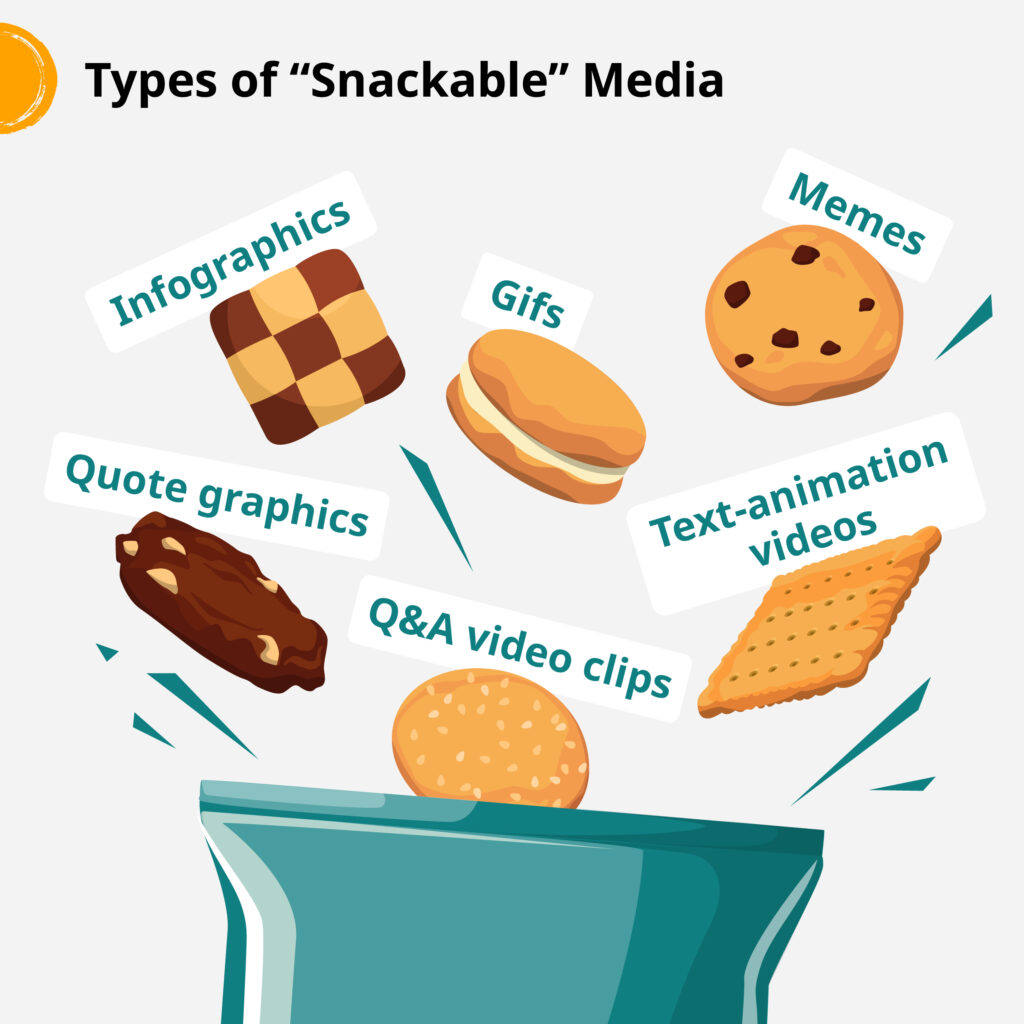While companies used to shell out huge amounts of money for a prime-time ad slot, there’s a new type of marketing that is taking over people’s screens: snackable content.
What content is ‘snackable’?
Attention spans are short. Really short. According to Microsoft, since 2000 the average attention span has dropped from 12 to 8 seconds. This means content needs to catch the eye right away. If you can get the gist of an ad while scrolling by, it’s snackable.
Right now, there is a big push for short-form video content. TikToks, YouTube shorts, and Instagram reels range anywhere from 15 to 90 seconds. But beyond these, there are other types of media that fall into the ‘snackable’ category. Such as:
- Gifs
- Infographics
- Memes
- Q&A video clips
- Quote graphics
- Text-animation videos

What are the benefits?
Compared to other types of content marketing, snackable content is relatively quick and easy to make. Creating a gif is a much shorter process than putting out a polished 5-minute promotional video and posting it directly to social media requires fewer steps than setting up a Google Ad campaign.
However, it doesn’t need to be one or the other. You can create snackable content from something already in your archives, such as videos, articles, or white papers. It can be complimentary to a content marketing strategy. Think of it as a preview, an appetizer to the full meal.
Some other points in favor of snackable content:
- Shareability: Building brand awareness in a saturated market is challenging at the best of times. But by creating a compelling visual, your audience can do part of the work for you by sending it to people in their network.
- Higher engagement: From likes, to comments, to shares, easier to consume content is easier to react to.
- Channel diversification: Companies often target the same online platforms (Facebook, Instagram, TikTok, YouTube) but you can try out secondary channels such as Reddit, Quora, or Pinterest without investing too heavily.
- Mobile optimization: A simple message means it’ll do well on a small screen. There’s no need to create complex visuals or give long explanations, and people can watch it anywhere, anytime on a handheld device.
- Customizability: It’s rare that one image or video will transcend culture or language, so if it only takes a few tweaks to appeal to a different geographic zone, you suddenly have access to a whole new market.
What are the drawbacks?
While having a reel go viral can be great for brand awareness, easy-to-consume content has its downsides.
- Missing information and nuance: A meme won’t tell you everything you need to know about a brand’s mission or their product lineup. It can help build up a following, but at a certain point, you need people to come to your site for more information.
Which leads to the next big issue:
- Getting people off a scrolling platform: If someone is having a fun time on TikTok or falling down a YouTube rabbit hole, it can be difficult (but not impossible!) to get them to leave that app and go to your site to learn more. Be realistic about user behavior and align your goals accordingly.
Best practices for short content
Right off the bat, have a strategy.
Sure, a meme only takes a few minutes to throw together, but what type of humor will your audience appreciate? And what will miss the mark? How will you measure if your content is successful?
To make sure you’re keeping your content tailored to your target market, do your due diligence before creating anything. Whether that means drawing up full-blown user personas or a general breakdown of your target markets, give yourself some parameters and metrics.
Get to know your audience: This is marketing 101, but take the time to understand their preferences, goals, humor etc. Content that appeals to a 45-year-old food inspector will be wildly different than something intended for a 19-year-old college student.
Define your goal: Are you looking to change your brand image or promote a new campaign? These are two different goals that will require very different types of content.
Make content that people want to share: Whether it makes people laugh or learn something new, there needs to be a reason that someone would want to show this to a friend.
Use strong visuals and keep it simple: You only have a few seconds, sometimes even less. Whether you’re making a clever pun or catching people by surprise, use all the visual tools at your disposal to make your content memorable.
Make it mobile-friendly: Pay attention to formats and layouts. You don’t want to have part of your message cut off or hard to read because of a problem in the design workflow.
Keep trying new things: The world of marketing is constantly changing so you need to be adaptable. Don’t be afraid to try different kinds of ideas on different platforms.
What happens after people view snackable content?
While it’s easy to see memes and gifs as purely entertaining content, it’s important to keep in mind that people do make the jump from short-form to long-form content. In fact, 59% of Gen Z use short-form video apps to discover new things and then seek out more information about the topic.
While short-form content doesn’t always need to have a call to action, it should be compelling enough to share or to spark curiosity. As you build up your portfolio of content and start putting it out into the world, you’ll get a better idea of what works best on what platform.



